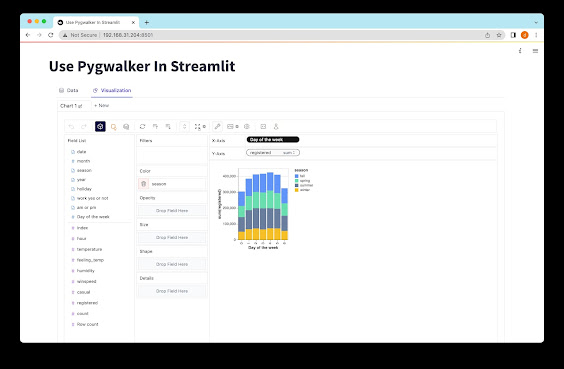Vector Database: The Powering Force Behind AI
Vector Database: The Powering Force Behind AI
The world of AI is rapidly advancing, with new innovations and developments taking place every day such as LangChain, the concept of Augmented Analytics, and other ChatGPT-based tools Data Science. One of the key pillars of AI is the use of vector database, which helps in managing unstructured data. In this article, we will explore the concept of vector database and how it works for AI.
Introduction to Vector Database
A vector database is a database that stores vectors and enables vector-related operations like nearest neighbor searches, similarity searches, and clustering. It is designed to handle large data sets consisting of high-dimensional data points. Vector database stores numerical data as vectors in a high-dimensional space, making it easy to analyze and process.
The concept of vector database is an essential part of machine learning models, especially in deep learning and natural language processing (NLP) algorithms. Vector databases are used to store image data, audio data, and text data, enabling large-scale processing and analysis.
How Does Vector Database Work for AI?
Vector databases work by using a data structure called an ANN search tree, or approximate nearest neighbor search tree. In this search tree, vectors are organized in a tree-like structure, where each node represents a small subset of vectors. A query vector is then used to traverse the tree, searching for the nearest vector to the query. This process enables fast and efficient similarity searches, which is critical for AI.
The use of vector database in AI applications is vast, especially in NLP algorithms, where it helps in analyzing and processing large amounts of text data. Vector database enables efficient document similarity searches, which is essential for text classification, document clustering, and information retrieval. It also enables efficient nearest neighbor searches for language model applications like ChatGPT Data Science, a chatbot development platform.
Vector databases can carry out multi-tenant operations that enable data isolation and partitioning of data. This allows for efficient and scalable data processing, especially in cloud-native environments. APIs provide ease of usability and can be easily integrated with applications. Furthermore, vector databases are highly scalable, making it possible to handle large amounts of data without compromising performance, tunability, or usability.
Vector Search Libraries for Vector Database
FAISS, ScaNN, HNSW, and Milvus are examples of vector search libraries that are designed to work with vector databases. These libraries provide scalar or vector indices that enable efficient integration between vector databases and ANN search algorithms. With these libraries, scaling a vector database becomes easy, enabling the use of vector databases in various applications.
Vector Database vs. Vector Search Libraries
Vector databases and vector search libraries are not the same things. While vector databases are designed to store and manage high-dimensional data sets consist of vectors, vector search libraries are used by vector databases to carry out similarity searches efficiently. The combination of a vector database and vector search library is the most viable solution to manage high-dimensional data sets.
Benefits of Using a Vector Database for AI
There are several benefits of using a vector database for AI applications. Here are a few of them:
- Efficient and scalable data processing
- Multi-tenant operations that enable data isolation and partitioning
- APIs provide ease of usability and integration with applications
- Efficient nearest neighbor searches for language model applications
- Fast and efficient similarity searches, essential for text classification, document clustering, and information retrieval
Vector Databases for E-commerce
Vector databases are known to be efficient in handling high-dimensional data, making them an essential part of the e-commerce ecosystem. With a vector database, e-commerce businesses can process large amounts of data, including product descriptions, images, and customer behaviors, providing personalized recommendations and user experience. Other Open Source Data Analytics Tools might also increace your chance of success in E-commerce
Managed Solutions for Vector Database
Managed solutions offer data processing services using vector databases and vector libraries, giving users access to these solutions without worrying about infrastructure management. With managed solutions, users can focus on data processing without having to deal with the complexities of managing high-dimensional data sets.
Open Source Vector Database
Milvus is an open source vector database built for the purpose of managing high-dimensional data sets for AI applications. It offers user-friendly features and an easy-to-navigate UI, making it a perfect solution for the creation of AI models. With Milvus, users can store and manage a large amount of image data, audio data, and text data, making it a robust option for AI applications, which distances its self from other solutions such as Modin.
Fully Managed Vector Database
As previously mentioned, projects such as Milvus provide managed solutions for vector database, which means that users don't have to worry about infrastructure management. Milvus offers full management services, making it an excellent choice for AI developers who want smooth data processing without the burden of infrastructure management.
Conclusion
Vector database is a critical component of AI applications. It provides the ability to manage high-dimensional data sets with ease and efficiency, enabling fast search and analysis. The use of managed solutions like Milvus and vector search libraries like FAISS and ScaNN ultimately improve efficiency and scalability. As AI continues to advance, the role of vector databases in managing and analyzing high-dimensional data sets will only continue to grow.
Read more about Data Analysis

Comments
Post a Comment